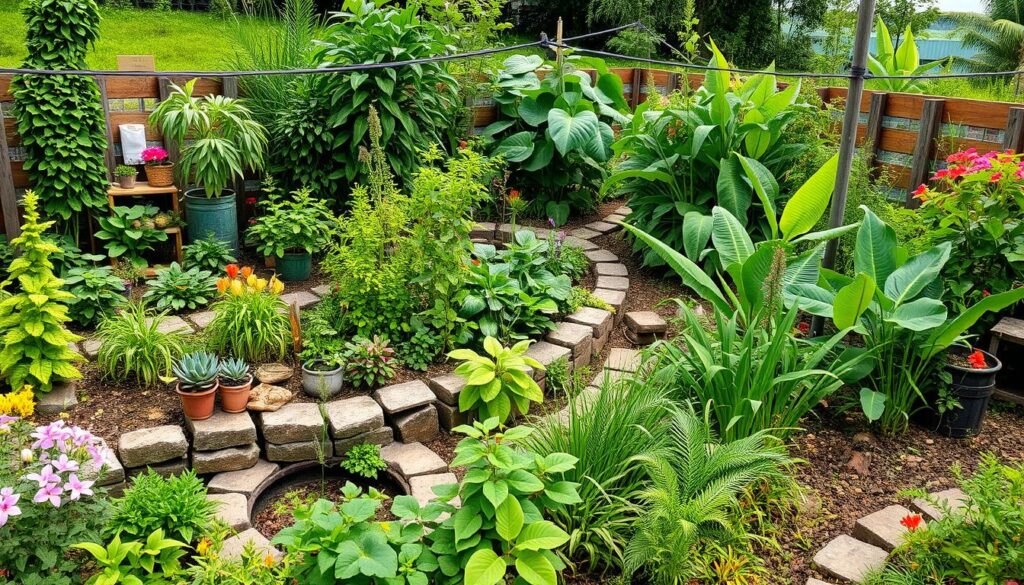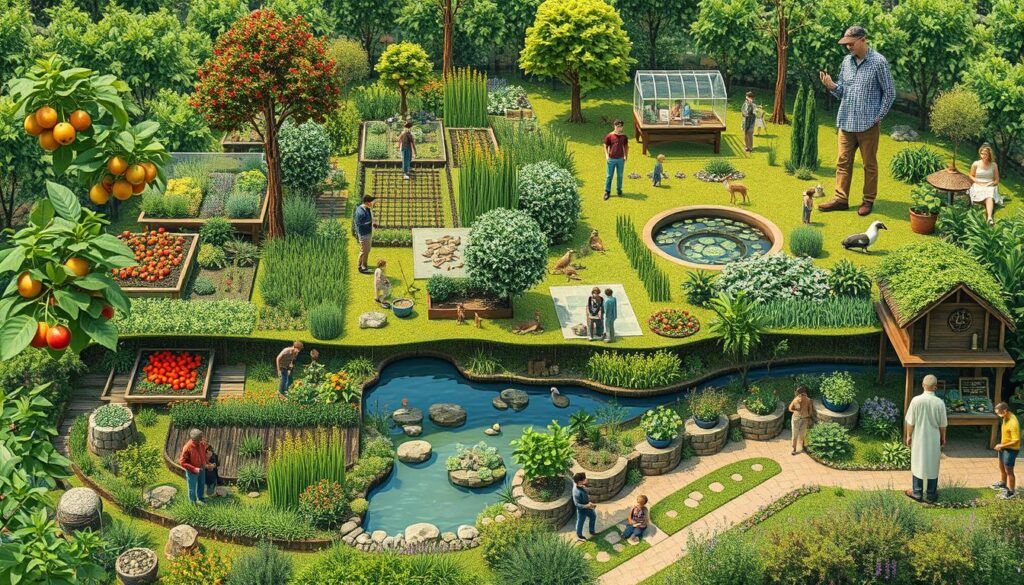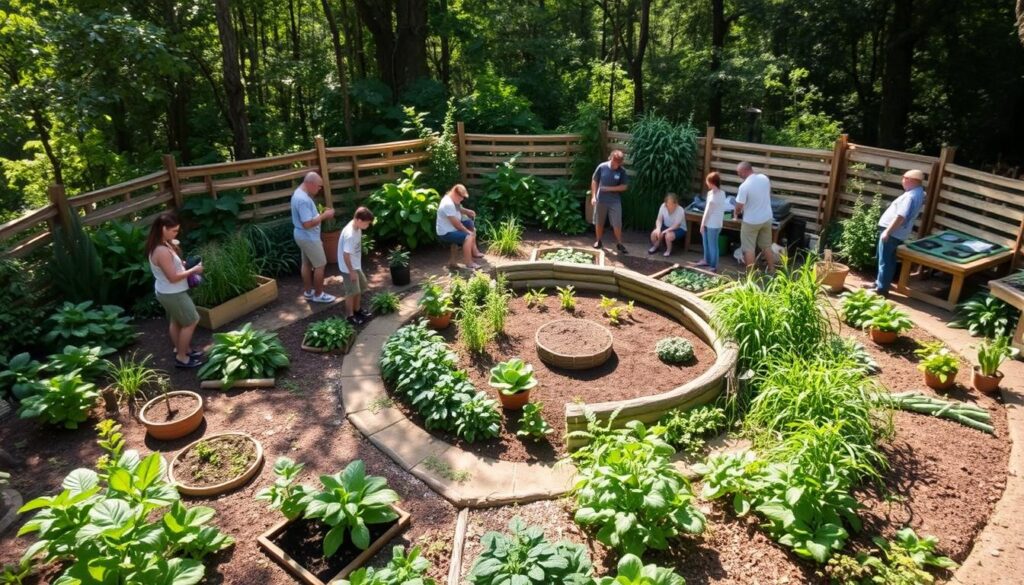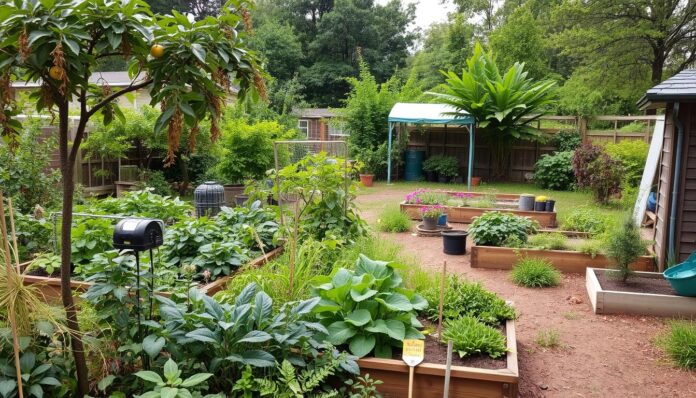Imagine if teaching could be as green as the nature we try to save. Permaculture teaching philosophy is all about making education sustainable. It focuses on teaching that helps our planet and communities thrive.
Permaculture is about creating ecosystems that need little help from humans. Can we use this idea in schools? It could make learning more about caring for our planet.
Key Takeaways
- Permaculture teaching philosophy prioritizes earth care, people care, and fair share
- Sustainable education practices can promote regenerative and self-sustaining ecosystems
- Permaculture teaching philosophy can transform the way we teach, making it more environmentally conscious
- Permaculture systems can thrive with less than 20% external inputs, relying on natural processes
- Communities practicing permaculture can see a 30% increase in local economic stability
- Permaculture practices can achieve a 50% reduction in water runoff through better soil management techniques
Introduction to Permaculture Teaching Philosophy
Permaculture is a way of thinking that looks at how everything in the environment connects. It aims to teach us how to live in a way that’s good for the planet. This idea started in the 1970s with Bill Mollison and David Holmgren, who coined the term “permanent agriculture.”
This teaching method focuses on taking care of the environment. It teaches people to live in a way that’s kind to the earth. By learning about permaculture, students get to see how everything is connected.
- Emphasizing the importance of biodiversity and ecosystem services
- Promoting the use of renewable resources and reducing waste
- Encouraging community involvement and cooperation
Permaculture teaches us to care for the earth and work together. It helps us see the world in a new way. This way of learning encourages us to be good stewards of the planet.
Core Principles of Permaculture
Permaculture is all about regenerative design principles that help us live sustainably. It’s about working with nature, not against it. The main ideas of permaculture are to observe and interact with nature, catch and store energy, and get a yield. These ideas are key for teaching about sustainable living and nature.
Some important permaculture principles are:
- Observe and interact: Understanding nature’s patterns and relationships to build sustainable systems.
- Catch and store energy: Using and saving energy to cut down on waste and boost efficiency.
- Obtain a yield: Getting something useful while keeping the system healthy and intact.
To learn more about permaculture, check out permaculture practice. It explains permaculture’s ethics and principles.
By using these principles, teachers can make education more green and nature-focused. This supports nature-based curriculum development and regenerative design principles.
The Roles of Teachers in Permaculture
Teachers are key in permaculture, acting as facilitators, not just instructors. They use experiential learning methods to make learning fun and effective. This hands-on approach helps students grasp permaculture better.
Teaching sustainably is also crucial. Teachers help students care for the environment and embrace sustainability. They do this by using strategies like:
- Encouraging students to participate in outdoor projects
- Teaching with local and recycled materials
- Adding permaculture to school curricula
By teaching sustainably and using experiential learning methods, teachers prepare students for a green future. As more focus on sustainable education grows, teachers’ roles in permaculture will become even more vital.
| Strategy | Description |
|---|---|
| Outdoor activities | Encourage student participation in outdoor projects and activities |
| Local materials | Use local and recycled materials in the classroom |
| Curriculum integration | Integrate permaculture principles into existing curricula |
Cultivating a Permaculture Mindset
Permaculture is a design for living that focuses on sustainability. It takes inspiration from nature’s ecosystems. By using a holistic learning approach, teachers can help students see the world in a new light. This way, they learn to live in harmony with nature.
At the core of permaculture is caring for the environment. This means using resources wisely and living sustainably. By teaching these values, students can understand their role in the natural world.

- Observing and interacting with natural ecosystems
- Using renewable energy sources, such as solar and wind power
- Implementing closed-loop systems to minimize waste
By following these principles, people can live more sustainably. This helps make our planet healthier and more vibrant.
Methods of Teaching Permaculture
Teaching permaculture well mixes hands-on learning, using technology, and outdoor fieldwork. It also uses regenerative design principles. This way, teachers can make lessons fun and interactive. It helps students really get permaculture.
It’s key to use nature in teaching permaculture. This lets students feel connected to the environment. They learn to care for it. There are many ways to do this, like:
- Hands-on activities, such as gardening and conservation work
- Outdoor classrooms and field trips to permaculture sites
- Integrating technology, such as online courses and educational software
These methods help create a full learning experience. It makes students understand permaculture better.
The main goal of teaching permaculture is to give students the skills for a sustainable future. By using nature and regenerative design, teachers prepare the next generation. They help create a greener world.
| Method | Description |
|---|---|
| Hands-on activities | Practical experiences, such as gardening and conservation work |
| Outdoor classrooms | Learning in natural environments, such as parks and permaculture sites |
| Integrating technology | Using online courses, educational software, and other digital tools |
Designing a Permaculture Curriculum
Creating a permaculture curriculum needs focus on sustainable education and a holistic learning approach. This method aims to build a complete and effective curriculum. It encourages learning that connects with nature and promotes recycling of energy and materials.
Studies show that permaculture design can apply to social systems too. Its principles guide a design process. Educators can craft a better curriculum by using sustainable education and a holistic learning approach.
Key Topics to Include
- Organic agriculture
- Agroforestry systems
- Sustainable forestry
- Urban permaculture
Age-Appropriate Teaching Techniques
Teaching methods should match the age and needs of students. For younger students, hands-on and outdoor learning works well. Older students might benefit from more theoretical and analytical teaching.
By using sustainable education and a holistic learning approach, educators can make a permaculture curriculum. This curriculum supports ecological connections, closed energy and material loops, and sustainable living spaces.
| Topic | Description |
|---|---|
| Permaculture Design | A system for designing permanent habitations that emphasizes ecological connections and closed energy and material loops. |
| Sustainable Education Practices | Practices that promote ecological connections, closed energy and material loops, and sustainable human habitats. |
| Holistic Learning Approach | An approach that focuses on creating a comprehensive and effective curriculum that promotes ecological connections and closed energy and material loops. |
Assessing Learning Outcomes in Permaculture
Checking how well students learn is key in permaculture education. It helps teachers see if their methods work and need changes. By using hands-on learning, teachers make classes more fun and interactive. This way, students learn by doing, not just listening.
Some good ways to check learning include:
- Watching how students take part in activities
- Looking at their projects to see if they get permaculture
- Talking with students often to see how they’re doing and what they need to get better
By using hands-on learning and teaching about caring for the environment, teachers help students understand sustainable living better. This helps create a fairer and greener future.
Community Involvement in Permaculture Education
Community involvement is key in permaculture education. It lets people come together and learn from each other. By using regenerative design principles, communities can build sustainable systems that help everyone. This way of learning focuses on nature-based curriculum development. It helps people understand the natural world and their role in it.
Community gardens are a great example of this. They bring people together to grow food and learn about gardening. These gardens offer fresh produce and are centers for community activity and learning. By teaching nature-based curriculum development in these gardens, educators help people appreciate nature and sustainable living.

Community involvement in permaculture education can also be through workshops, lectures, and hands-on training. These programs teach people how to create their own sustainable systems. Whether it’s a backyard garden or a big farm, applying regenerative design principles and nature-based curriculum development makes systems sustainable, resilient, and adaptable.
Challenges in Permaculture Teaching
Teaching permaculture comes with its own set of challenges. These include dealing with different learning styles and facing resistance to change. To overcome these, educators can use a holistic learning approach. This method focuses on environmental stewardship principles in permaculture.
One major challenge is meeting the diverse needs of students. Some might learn better through hands-on activities, while others prefer theory or online classes. To address this, teachers can mix up their teaching methods.
- Hands-on learning experiences, such as workshops and fieldwork
- Theoretical learning, such as lectures and online courses
- Collaborative learning, such as group projects and discussions
By adopting a holistic learning approach, teachers can create a welcoming space for all. This approach helps students grasp permaculture better. It also prepares them for careers in sustainable development.
Connecting Permaculture to Sustainable Development
Permaculture is a design philosophy for living sustainably. It draws inspiration from natural ecosystems. Educators use it to teach sustainable living in many areas, like farming and education.
It also focuses on nature-based learning. This method teaches ecological principles in all aspects of life. It helps students understand the need for sustainability and their role in it.
Global Goals and Permaculture
The United Nations’ Sustainable Development Goals (SDGs) aim for a better future. Permaculture helps achieve goals like ending hunger, ensuring clean water, and fighting climate change. It teaches students about sustainability and their part in it.
Case Studies of Successful Programs
Many groups have shown permaculture’s success. For example, the Institute for Permaculture Education in Portland, Oregon, teaches sustainable living. The European Permaculture Teachers’ Partnership is making permaculture a key part of education.
| Organization | Program | Focus |
|---|---|---|
| Institute for Permaculture Education | Nature-based curriculum | Sustainable living and ecological principles |
| European Permaculture Teachers’ Partnership | Comprehensive educational reform model | Permaculture as a framework for sustainable development |
These examples show permaculture’s role in sustainable development. They highlight the value of regenerative design and nature-based learning in education.
Resources for Teachers
Teachers can find many resources to add sustainable education and a holistic learning approach to their classes. These tools help make teaching permaculture more effective and complete.
There are textbooks and academic journals that explain permaculture’s philosophy and how to apply it. Online courses and webinars also offer a great way to learn about permaculture. This makes it easy for teachers to add it to their curriculum.
For example, the 72-hour Permaculture Design Certificate Course has helped thousands of students. The Permaculture Project also offers advanced intensives. These courses teach teachers how to use permaculture design principles in their classes.
Using these resources, teachers can create a learning environment that focuses on sustainability. This approach helps students understand permaculture better. It prepares them for a future that values sustainability.
Future of Permaculture Education
Permaculture education is growing, and it’s key to use hands-on learning. This helps students really get sustainable practices. It shows them how to keep our ecosystem healthy.
Hands-on learning in permaculture lets students feel connected to nature. It teaches them to care for the environment. This includes reducing waste and saving resources.
Some trends in teaching for sustainability are:
- More focus on working together in communities
- Using technology to make learning better
- Teaching the whole person, not just one part
As permaculture grows, we need new training programs. These should meet different learning needs. This way, we can teach people to care for the earth and build a sustainable future.

| Organization | Initiative | Impact |
|---|---|---|
| Renuable Kids | Hands-on permaculture education | 70% increase in eco-friendly behaviors among participants |
| Permaculture Education Institute | Global permaculture design certifications | Thousands of students educated worldwide |
The Role of Technology in Permaculture Education
Technology is key in permaculture education, making learning fun and hands-on. It uses regenerative design principles and nature-based curriculum development. This helps create engaging learning spaces. It’s used in many ways, like digital learning platforms and virtual reality.
Technology in permaculture education has many benefits. For instance:
- More people can access permaculture courses and resources.
- Students get more involved and interested in learning.
- They remember what they learn better.
Virtual reality is a great tool. It lets students explore and interact with virtual ecosystems. This is great for those without access to real permaculture sites. Or for those who want to try out different techniques in a virtual space.
By using technology, permaculture education becomes more open, fun, and effective. This helps us move towards a more sustainable future.
| Technology | Benefits |
|---|---|
| Digital platforms | Increased accessibility, enhanced student engagement |
| Virtual reality | Simulated permaculture practices, improved retention of knowledge and skills |
Creating Inclusive Learning Environments
Teachers can make learning spaces welcoming and effective by using a holistic approach. This method looks at the whole person, including their social, emotional, and environmental sides. It helps students see how we are all connected to nature.
Here are some ways to make learning spaces inclusive:
- Using diverse teaching methods to engage students with different learning styles
- Encouraging student participation and feedback to create a sense of community
- Incorporating real-world examples and case studies to make learning relevant and meaningful
Creating inclusive learning environments helps students feel they belong. This can lead to better grades and a love for learning that lasts a lifetime. It’s crucial for teachers to focus on making learning spaces that meet the needs of all students.

The Impact of Permaculture Teaching Philosophy
Permaculture teaching philosophy deeply affects students and communities. It promotes sustainable education practices and regenerative design principles. These principles help educators teach in a more effective and sustainable way.
Students learn a lot from permaculture. They become more aware of environmental issues and how to solve them. This is thanks to hands-on learning and spending time outdoors, which helps them connect with nature.
Communities benefit from permaculture teaching philosophy in many ways. For example:
- They get more food through sustainable farming
- They work better to protect and manage the environment
- They become more united and engaged with each other
By using sustainable education practices and regenerative design principles, teachers prepare students to help make the future better.
| Statistic | Description |
|---|---|
| Number of permaculture students | Increased rapidly in the 1980s |
| Permaculture Design Certificate (PDC) holders | Thousands emerge annually |
| Core ethics of permaculture | People Care, Earth Care, and Fair Share |
Conclusion: Embracing a Permaculture Teaching Philosophy
As we wrap up our look at permaculture teaching philosophy, it’s clear it’s a game-changer. It offers a way to change education and help protect our planet. By using permaculture’s design principles, teachers can help students become part of a sustainable future.
Summary of Key Insights
We’ve covered the heart of permaculture, like observing nature and getting a yield. We’ve seen how teachers are key in building connections and teaching permaculture. Hands-on and outdoor learning show the strength of real-world experience.
Call to Action for Educators
The insights from this journey highlight the need for educators to adopt permaculture. By using a holistic approach, teachers can inspire students to care for the earth. It’s time to start making a difference and grow a better future.

